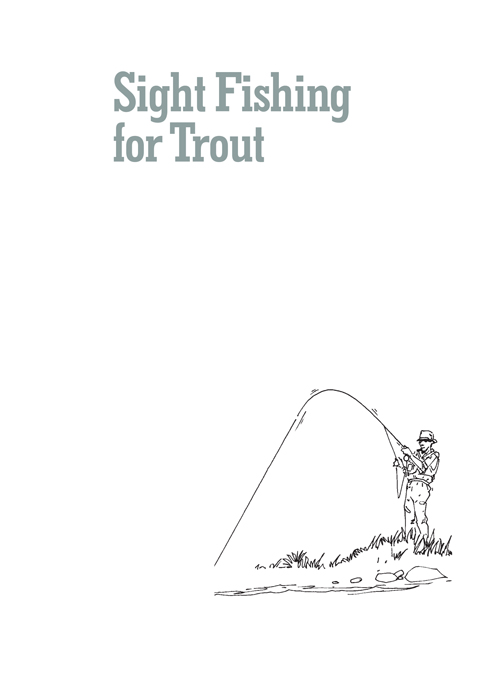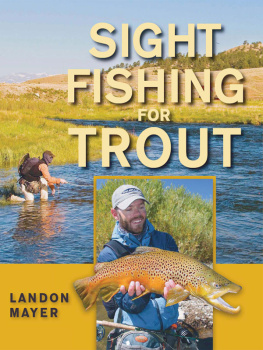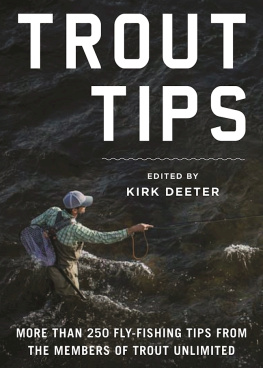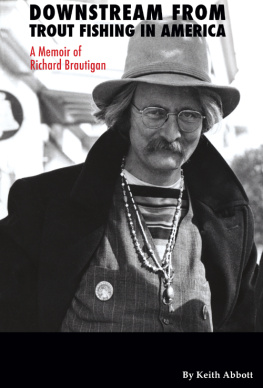Landon Mayer - Sight Fishing for Trout
Here you can read online Landon Mayer - Sight Fishing for Trout full text of the book (entire story) in english for free. Download pdf and epub, get meaning, cover and reviews about this ebook. year: 2009, publisher: Stackpole Books, genre: Religion. Description of the work, (preface) as well as reviews are available. Best literature library LitArk.com created for fans of good reading and offers a wide selection of genres:
Romance novel
Science fiction
Adventure
Detective
Science
History
Home and family
Prose
Art
Politics
Computer
Non-fiction
Religion
Business
Children
Humor
Choose a favorite category and find really read worthwhile books. Enjoy immersion in the world of imagination, feel the emotions of the characters or learn something new for yourself, make an fascinating discovery.
- Book:Sight Fishing for Trout
- Author:
- Publisher:Stackpole Books
- Genre:
- Year:2009
- Rating:5 / 5
- Favourites:Add to favourites
- Your mark:
- 100
- 1
- 2
- 3
- 4
- 5
Sight Fishing for Trout: summary, description and annotation
We offer to read an annotation, description, summary or preface (depends on what the author of the book "Sight Fishing for Trout" wrote himself). If you haven't found the necessary information about the book — write in the comments, we will try to find it.
Sight Fishing for Trout — read online for free the complete book (whole text) full work
Below is the text of the book, divided by pages. System saving the place of the last page read, allows you to conveniently read the book "Sight Fishing for Trout" online for free, without having to search again every time where you left off. Put a bookmark, and you can go to the page where you finished reading at any time.
Font size:
Interval:
Bookmark:



To my mom, Roberta Lee Mayer-Skar, the woman who raised me to understand that love, morals, honesty, and respect would lead me to accomplish any goals that I set my mind to. With her devotion as a single mother and her dedication to raising my brother, Sean Mayer, my sister, Lauren Skar, and me, I was able to pursue my passion, career, and lifestyle. Following her example as a parent taught me to become the best father I can possibly be and a teacher to others.
Copyright 2010 by Landon Mayer
Published by
STACKPOLE BOOKS
5067 Ritter Road
Mechanicsburg, PA 17055
www.stackpolebooks.com
All rights reserved, including the right to reproduce this book or portions thereof in any form or by any means, electronic or mechanical, including photocopying, recording, or by any information storage and retrieval system, without permission in writing from the publisher. All inquiries should be addressed to Stackpole Books, 5067 Ritter Road, Mechanicsburg, PA 17055.
Printed in China
10 9 8 7 6 5 4 3 2 1
First edition
Photography by the author unless otherwise noted
Library of Congress Cataloging-in-Publication Data
Mayer, Landon R.
Sight fishing for trout / Landon R. Mayer. 1st ed.
p. cm.
Includes index.
ISBN 978-0-8117-0551-6
eISBN 978-0-8117-4210-8
1. Trout fishing. I. Title.
SH687.M3425 2010
799.1757dc22
2009008960
Contents

Foreword

M ost of us fish for trout without actually observing themtheyre just a riseform on the surface, or theyre somewhere below in the opaque water column, perhaps eating nymphs. We see the fish when it surfaces to take our fly or when our strike indicator dips with a take. But we should learn to think with our eyes, the way the true predator does when it searches for food. That is the subject of Landon Mayers new book.
When I taught my grandson to fly fish, I said to him, Ben, you must learn to observe, to watch your fly as it floats, to think with your eyes. Otherwise you will not see the fish take your fly, and you will not be able to react fast enough to strike and hook the fish. Eventually you will habitually fix your eyes on the fly and react. I explained to him that we would go to a gin-clear stream where he could observe directly the feeding and other behaviors of trout, to learn about the fish he will try to catch. I explained to him that I had learned the most about trout by observing them in the clear waters of New Zealand. Then, I told him, I began to realize truths about trout that I had never understood before.
Trout are like chameleons: they naturally take on the colors of the stream bottom on which they dwell. They are drift feeders, facing upstream to take their food as it drifts to them. They are investigators, taking into their mouths every drifting tidbit and eating or rejecting it depending on its food value. They have no hands, so they must use their mouths to do the interception and taste testing.
They have feeding lies and hiding lies; one provides them with sustenance and the other with safety. Their sense of smell is much greater than ours, for the olfactory portions of their brains are more evolved than oursoccupying a larger percentage of their (tiny) brains. Wild trout are particularly alarmed by the smell of man; thus, in New Zealand guides always fish upcurrent of the trout.
Trout evolved as both predator and prey: As predator species they prey on drifting aquatic insects and fish. As prey species, they must be able to spot approaching predators from above (osprey and eagles) and below (mink and otter). Their eyesight is nearly full circle (and in all planes), so they can see in all directions except about 10 to 15 percent directly behind. As prey, external movement is their key alarm signal. Their entire bodies act as highly sensitive sound receivers, and wading sounds in quiet waters send them fleeing.
So where does this leave us as trout predators? As Robert Bachman learned in his three-year doctoral studies monitoring trout behavior, conducted on the Penn State University water on Spruce Creek, most wild trout disappeared from their feeding lies before expert fly fishers could approach the stream using stealth and camouflage clothing. Considering this, can we even hope to get close enough to wild adult stream trout to observe themand catch them?
Yes, we can. There is an old fishing adage that says, Ten percent of the fishermen catch 90 percent of the fish. The percentage is overstated. It is more accurate to assert that 10 percent of the fishermen catch 70 percent of the older trout, and they catch them by first locating them, observing their feeding behavior, and then selecting the right fly and presenting it the way the fish expects to see its prey. All of this successful predatory behavior is predicated on our experience. And the most important element of that experience is learning how to spot fish (especially trout in streams), and especially the largest, oldest specimens of the species.

John Randolph lifts a New Zealand brown that he caught by sight fishing. JOHN RANDOLPH
Developing the eye of the hunter (coure doille) is key to successful trout spotting. If you are one of those hunters who can spot deer while speeding by woods, then you understand the concept of the hunters eye. Human physiologists explain the reaction of the human eye to tonal differences this way: if one differently colored M&M is placed on a traveling belt of uniformly colored M&M candies, the eye instantly picks out the fraud by tonal contrast. Once the hunters eye learns to recognize prey shape (morphology), tone, shadow image and movements that dont fit the surroundings, and preferred feeding and hiding locations, his search-image recognition and eye triggers are educated. He begins to think with his eyes. More than half his work is conditionally prescribed. The rest is stalking, spotting, and presentation.
Most successful hunters are born with inherent predatory instincts. They are driven to catch (or kill) a prey. Humans evolved as hunters, after all. But even nonhunters can become superb fishers through training, if they have enough drive to learn the elements of eye-search and recognition as explained by Landon Mayer. It helps to begin the eye training where large fish, especially trout and steelhead (but also smallmouth bass), are found in clear water. Large steelhead enter Great Lakes tributary streams in spring and fall in preparation for spawning. The streams are often small, shallow, and clear, and the fish are many and large. These settings provide excellent opportunities to train your eyes to spot fish and to develop techniques for presenting flies to them, as well as hooking, playing, and releasing them.
What you learn by spotting and watching trout in clear water is that each trout has a distinct personality, much like humans and other animals. This makes fish watching more fascinating, a discipline in itself. Some trout prefer to feed left; others right. Some, in New Zealand for example (where there are no trout predators except humans), prefer to take naps, often in full daylight. Some seem to sulk or lie still. Others are extremely aggressive to fish intruders. Some feed languidly, others frenetically. Some are suckers for the dry; others feed almost exclusively on nymphs in their safe zone, that bottom six inches or foot of water where they feel safe. Others rise upward through the water column, feeding freely and comfortably at all levels.
Font size:
Interval:
Bookmark:
Similar books «Sight Fishing for Trout»
Look at similar books to Sight Fishing for Trout. We have selected literature similar in name and meaning in the hope of providing readers with more options to find new, interesting, not yet read works.
Discussion, reviews of the book Sight Fishing for Trout and just readers' own opinions. Leave your comments, write what you think about the work, its meaning or the main characters. Specify what exactly you liked and what you didn't like, and why you think so.










